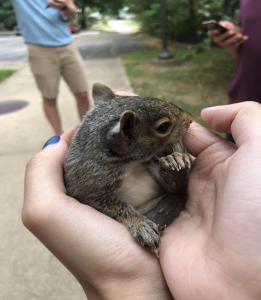In the first few paragraphs of the chapter “Great Blue Heron” in Refuge: An Unnatural History of Family and Place, Terry Tempest Williams analyzes her personal vision of a female heron, calling her “a bird who knows how to protect herself,” who has “stayed home” and “weathered the changes well” (Williams 285). Williams tips her hand a little more when she hypothesizes that “this is a generational stance, the legacy of her lineage” and says that she herself “would like to believe [the heron] is reclusive at heart, in spite of the communal nesting of her species” (285). This opening section fits in with a theme explored at length in Refuge: the idea of seeing oneself reflected in nature at the expense of reducing nature to an abstraction. Williams takes this individual heron, about whom she knows very little, and not only pads out her understanding of the bird with assumptions and guesses about her abilities, history, and family, but contradicts what she does know about the bird in order to further compare it to herself. In this way, she first reduces the bird to a metaphor or symbol, then to a complete abstraction, the image of a heron without context.
This, to clarify, is not a bad thing in and of itself. Any time a human writes about a non-human, some human attributes are going to be passed down. Even beyond that, it would appear that Williams’ intent is not so much to destroy the heron but to recreate herself. At the end of this section, she calls back to the central theme of the book, saying “refuge is not a place outside myself. Like the lone heron who walks the shores of Great Salt Lake, I am adapting as the world is adapting” (286). This illustrates how this chapter, which chiefly concerns her and Mimi travelling to see Nancy Holt’s sculpture “Sun Tunnels” and feeling a connection to the land and the universe there, relates to the overarching theme of seeking refuge from the worlds around and within oneself; Williams is using the abstraction of the heron to illustrate the importance of an adaptable, dynamic refuge by showing how resistance to change requires change.
However, in the interest of balance, it only seems fair to put Williams on the back-burner for the moment and inspect the bird she abstracted: the female great blue heron. According to allaboutbirds.org, the female great blue heron selects a male based on a few factors, including an elaborate mating ritual and the quality of the nesting territory secured by each male. Once she has selected a mate, she uses materials provided by him to construct a platform and saucer-shaped nest cup before laying a clutch of two to six eggs. She incubates these eggs for about a month, then rears the gray-downed, blue-eyed chicks for 49-81 days before they are ready to fly. During this time, the female and her mate remain together, only splitting up at the end of the year-long cycle when it is time for the pairs to reshuffle. This brings to mind my own experiences with great blue herons in the swamps of Louisiana, where many nests can be found perched precariously in trees and bushes and the birds themselves can often be seen wading through the shallows with their long, slender legs or flying overhead with their necks curled into compact S-shapes. These elegant figures seem to contrast against the more solid constructs of the trees, toads, and turtles around them, especially when their blue wing-tips are seen seemingly slicing through the trees and reeds behind them, defying their surroundings, resisting simplicity.

